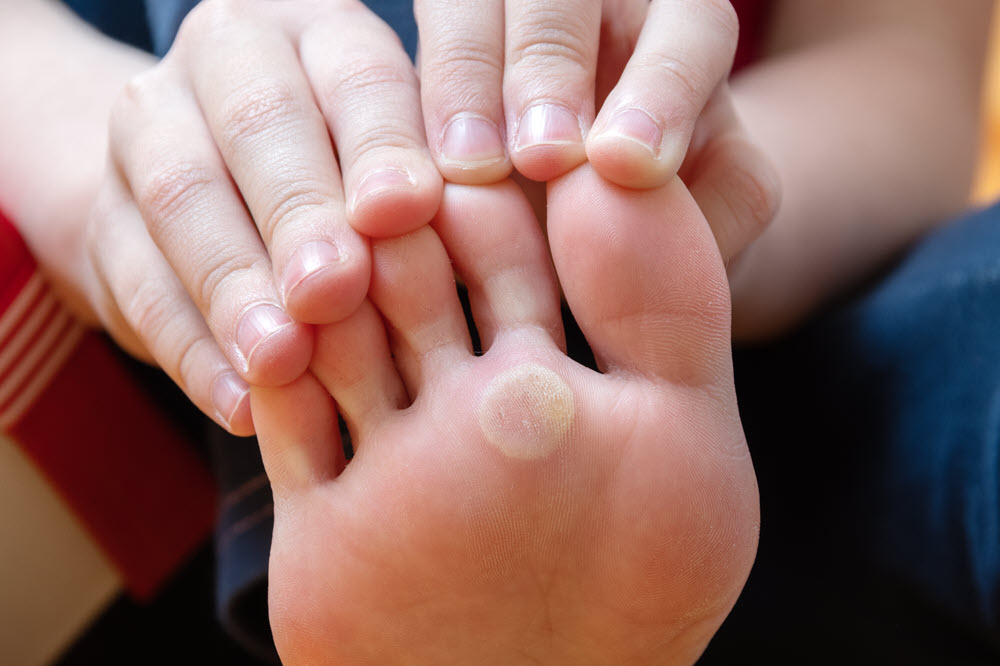Infections - Prevention, Diagnosis & Treatment
Plantar Warts
By S.I. (staff writer) , published on October 19, 2021

Medicine Telehealth Health warts viral
Plantar warts are commonly occurring skin lesions that are caused by the human papillomavirus (HPV). They grow on the plantar surface or sole [1].
The common places for plantar warts to grow are weight-bearing areas of the sole, such as the heel and base of toes. The pressure put on them when they grow on such areas leads to them growing inwards with a callus-like skin on their surface.
There are two types of plantar warts:
- Solitary warts
- Mosaic warts.
Solitary warts are single warts that tend to grow in size and mosaic warts are small warts that are found in clusters.
The human papillomavirus enters the body via any cut or breaks in the skin of the sole. This virus thrives in moist and warm places; thus, people walking barefoot in damp places can develop plantar warts.
What are the Symptoms of Plantar Warts?
When the person has a plantar wart, they will have the following symptoms [2]:
- A flat lesion that seems to be growing inward.
- The lesion feels tender when pressure is put on it during activities such as walking or standing.
- Pain in the lesion when it is squeezed.
- A callus-like skin lesion.
- The ridges of the sole of the affected foot are disrupted due to the lesion.
- Dots have formed on the surface of the lesion, which is black. These dots are small blood vessels with clots in them. These black dots are commonly known as wart seeds.
What are the Causes of Plantar Warts?
Plantar warts are caused by some strains of human papillomavirus. The virus finds a way to get under the skin of soles by any cut or break in it [3].
A warm and moist environment is best for the virus to thrive. When a person walks barefoot in such areas, they may get infected by the virus, leading to the development of plantar warts. If there is a spread of the virus in the body after infection, it may lead to the formation of other warts around the body.
What is the Treatment of Plantar Warts?
Main Treatment Options [4]:
·Salicylic acid
A stronger salicylic acid solution is prescribed to treat plantar warts. When salicylic acid is applied to the wart every day, it leads to the removal of layers of the wart one by one.
Applying salicylic acid may also lead to stimulation of the immune system to work against the plantar wart. The side effects of this medication are irritation and discoloration of the skin where it is applied.
·Cryosurgery
Liquid nitrogen is used in cryosurgery. In this method, liquid nitrogen is applied to the wart using a cotton swab or a spray [5].
The application of liquid nitrogen leads to the formation of blisters, which results in the death of tissues in plantar warts. Consequently, sloughing of dead tissue happens within 7 days.
Since this procedure can cause pain to the patient, local anaesthesia is used to numb the area.
Other Treatment Options:
·Laser therapy
·Immunotherapy
·Trichloroacetic acid
·Electrodessication and curettage
References:
- https://pubmed.ncbi.nlm.nih.gov/29379975/
- https://www.ncbi.nlm.nih.gov/books/NBK431047/
- https://pubmed.ncbi.nlm.nih.gov/29379975/#:~:text=Verrucae%20plantaris%20(plantar%20warts)%20are,cellular%20and%20humoral%20immune%20responses.
- https://www.ncbi.nlm.nih.gov/books/NBK431047/#:~:text=Salicylic%20acid%20is%20often%20a,are%20also%20used%20for%20treatment.
- https://pubmed.ncbi.nlm.nih.gov/11072922/
Find articles related to: Medicine Telehealth Health warts viral
More articles about Infections - Prevention, Diagnosis & Treatment
Back to the Health Tips Index




